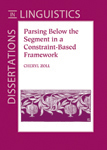

|
|
|
|

Parsing Below the Segment in a Constraint-Based FrameworkThis book proposes a new way of understanding the behavior of consonants and vowels in a broad cross-section of the world's languages. A new model of subsegmental phonology within Optimality Theory that differs from standard Autosegmental Phonology both in its limited use of representational distinctions and in the form of the grammar to which the representations submit is introduced. The research focuses particularly on floating features and ghost segments, and demonstrates that the current understanding of segmental representation fails to characterize the full range of subsegmental phenomena found cross-linguistically. I propose instead an analysis in which the grammar derives the variety of surface phenomena from a single underlying representation. The typology that results from this analysis correctly classifies the entire range of behavior associated with subminimal phonological units. This work thus both enlarges the empirical foundation on which an adequate theory of segment structure must be based, and in developing such an account sheds new light on classic problems of subsegmental parsing. The problems dealt with here include classics such as the pattern of liaison consonants in French, as well as more obscure phenomena such as the assignment of tone marking in the African languages Mende and Kukuya. It is the first book to apply the results of current phonological theory to this area. This book will be of great interest to linguists and to other people who are interested in knowing more about sound patterns in language. was Assistant Professor, Department of Linguistics and Philosophy, MIT, at the time of this publication. Contents
November 2014 3/1/98 ISBN (Paperback): 1575861305 (9781575861302)
Subject: Linguistics; Grammar--Phonology; Autosegmental Theory |
Distributed by the
University of Chicago Press |
|
pubs @ csli.stanford.edu
|
CSLI Publications
Stanford University Cordura Hall 210 Panama Street Stanford, CA 94305-4101 (650) 723-1839 |